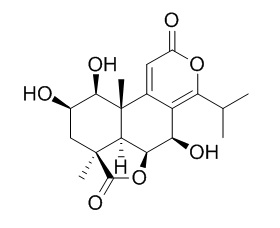Nagilactone B
Nagilactone B is a liver X receptor (LXR) agonist, selective LXR activation in macrophages with nagilactone B induces ABCA1- and ABCG1-mediated cholesterol efflux while exerting minimal effects on lipogenesis and lipid accumulation in liver, resulting in regression of atherosclerosis, and therefore might be a promising strategy for therapeutics.
Inquire / Order:
manager@chemfaces.com
Technical Inquiries:
service@chemfaces.com
Tel:
+86-27-84237783
Fax:
+86-27-84254680
Address:
1 Building, No. 83, CheCheng Rd., Wuhan Economic and Technological Development Zone, Wuhan, Hubei 430056, PRC
Providing storage is as stated on the product vial and the vial is kept tightly sealed, the product can be stored for up to
24 months(2-8C).
Wherever possible, you should prepare and use solutions on the same day. However, if you need to make up stock solutions in advance, we recommend that you store the solution as aliquots in tightly sealed vials at -20C. Generally, these will be useable for up to two weeks. Before use, and prior to opening the vial we recommend that you allow your product to equilibrate to room temperature for at least 1 hour.
Need more advice on solubility, usage and handling? Please email to: service@chemfaces.com
The packaging of the product may have turned upside down during transportation, resulting in the natural compounds adhering to the neck or cap of the vial. take the vial out of its packaging and gently shake to let the compounds fall to the bottom of the vial. for liquid products, centrifuge at 200-500 RPM to gather the liquid at the bottom of the vial. try to avoid loss or contamination during handling.
Front Pharmacol.2018, 9:236
Int J Mol Sci.2020, 21(7):2530.
Int. J. Mol. Sci.2022, 23(19), 11900.
Pharmaceuticals (Basel).2022, 15(8):982.
Journal of Food Quality2022, P:13, 6256310.
Antioxidants (Basel).2021, 10(11): 1802.
J Sep Sci.2021, 44(22):4064-4081.
Int J Mol Sci.2020, 21(6):2190.
J.Korean Soci. Food Sci. Nutri.2024, 53(11):1166-1177
Microorganisms.2021, 9(12):2514.
Related and Featured Products
Cardiovasc Res. 2016 Oct;112(1):502-14.
A novel small molecule liver X receptor transcriptional regulator, nagilactone B, suppresses atherosclerosis in apoE-deficient mice.[Pubmed:
27460841]
Atherosclerosis is the most common cause of cardiovascular diseases, such as myocardial infarction and stroke. We hypothesized that Nagilactone B (NLB), a small molecule extracted from the root bark of Podocarpus nagi (Podocarpaceae), suppresses atherosclerosis in an atherosclerotic mouse model.
METHODS AND RESULTS:
Male apoE-deficient mice on C57BL/6J background received NLB (10 and 30 mg/kg) for 12 weeks. Compared with the model group, NLB treatment (10 and 30 mg/kg) significantly reduced en face lesions of total aorta areas. In RAW264.7 cells, NLB significantly ameliorated cholesterol accumulation in macrophages via enhancing apolipoprotein A-I and HDL-mediated cholesterol efflux. Mechanistically, NLB induced messenger RNA and protein expression of the ATP-binding cassette transporter A1 (ABCA1) and G1 (ABCG1) in RAW264.7 and THP-1 cells. Liver X receptor (LXR) site mutations in the mouse ABCA1 promoter abrogated NLB-mediated luciferase reporter activity. LXRα and LXRβ small interfering RNA suppressed NLB-mediated induction of ABCA1 expression. Consistent with in vitro results, NLB induced ABCA1 expression and suppressed macrophage areas in the aortic sinus. Moreover, NLB treatment did not induce the protein expression of LXR in liver. Hepatic and intestinal cholesterol accumulation was significantly alleviated on NLB treatment. Besides, NLB significantly improved plasma lipid profiles in apoE-deficient mice.
CONCLUSIONS:
Selective LXR activation in macrophages with NLB induces ABCA1- and ABCG1-mediated cholesterol efflux while exerting minimal effects on lipogenesis and lipid accumulation in liver, resulting in regression of atherosclerosis, and therefore might be a promising strategy for therapeutics.



